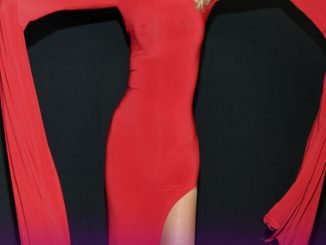A TV presenter with a traditional Māori face tattoo has calmly replied to negative comments from a viewer, proudly standing up for her cultural heritage and identity.
Facial tattoos often spark debates online. Some people think tattoos should only be on the body, while others understand and appreciate their cultural importance.
Oriini Kaipara, 41, made history when she became a newsreader for New Zealand’s Newshub. She is the first primetime TV news presenter to wear a moko kauae, a special facial tattoo for Māori women.
The Māori are the indigenous people of mainland New Zealand. They see moko kauae as important symbols of their heritage and identity. These tattoos, traditionally on the lips and chin, show a woman’s family ties, leadership, and honor her lineage, status, and abilities.

Oriini Kaipara. Credit: Oriini Kaipara / Instagram.
Despite receiving praise, one viewer named David expressed his dislike for Kaipara’s moko kauae in an email to Newshub.
He wrote, “We continue to object strongly to you using a Māori newsreader with a moku [moko] which is offensive and aggressive looking. A bad look. She also bursts into the Māori language which we do not understand. Stop it now,” according to the Daily Mail.
But Kaipara didn’t let David’s negative words stop her. She bravely shared screenshots of his messages on her Instagram story and responded calmly.
“Today I had enough. I responded. I never do that. I broke my own code and hit the send button,” she wrote on her Instagram story alongside a screenshot of David’s message.

Kaipara didn’t just share screenshots of David’s email, she also responded to him. She explained that his complaint wasn’t valid because she hadn’t broken any rules for TV.
She also corrected David’s spelling mistake. He called her tattoo a “moku” instead of “moko”.
In her email back to him, Kaipara said, “I think you don’t like how I look on TV. But tattoos and people with them aren’t scary or bad. We don’t deserve to be treated badly because of them.”
She asked him to stop complaining and to try to understand better. She even joked that maybe he should go back to the 1800s if he couldn’t accept people with tattoos.

Despite David’s negative words, Kaipara says she mostly gets nice comments, and mean ones are rare.
In an interview with the New Zealand Herald, Kaipara talked about how it’s important to have more Māori people in important jobs. She said, “The fact that my existence makes some people upset shows why we need more Māori people in every job.”
Kaipara’s calm response reminds us how important it is to be proud of who you are, even when people are mean. She’s inspiring others to be proud of themselves and stand up to unfair treatment.
What do you think of this story? Share your thoughts in the comments!
Simon Cowell Shocks Fans: His $600 Million Fortune Won’t Go to His Son
Simon Cowell is known for being a tough and brutally honest judge on TV talent shows. He is a producer and the creator of popular shows like *The X Factor* and *America’s Got Talent*, and he has done very well for himself throughout his career. Despite his tough TV persona, Simon Cowell is now a caring father. He has said that none of his $600 million fortune will go to his son, Eric. Instead, he plans to donate all of it to charity.

Simon Cowell is a very successful entertainment business owner, producer, and TV personality, known for judging talent competitions in both the UK and the United States. Now, he can add another role to his list: he is a father. Cowell became a father in 2014, a moment that he says changed him as a person. However, before the birth of his son, Eric, he mentioned in an interview that none of his $600 million fortune would be passed on to his son. He believes that passing down wealth to the next generation is not the right thing to do.

“I’m going to leave my money to someone—probably a charity, like kids and dogs,” Simon Cowell said in 2013. He believes in leaving a legacy instead of just passing down money to his son. Cowell thinks that helping his son develop a successful career is more important than giving him a lot of money.
“The goal is to give people opportunities so they can succeed, and to share your knowledge with them,” he explained. Simon Cowell’s net worth is around $600 million, and he plans to donate all of it to charity. He hasn’t decided which charity yet, but he mentioned it will likely be related to children or dogs.

Simon Cowell is not the only celebrity who has said their money will go to charity instead of their children. Famous TV anchor Anderson Cooper shares similar views. He welcomed his child via surrogacy in 2020 and said, “I don’t believe in passing on huge amounts of money. I’m not that interested in money, but I don’t plan to have a pot of gold for my son. My parents taught me that college will be paid for, and then he needs to get to work.”
One of the world’s richest people, Microsoft founder Bill Gates, has also promised that his children won’t inherit his billions. Most of his wealth, along with that of his ex-wife Melinda Gates, will go to the Bill and Melinda Gates Foundation. This foundation aims to eliminate poverty, hunger, and disease worldwide. Gates explained, “It’s not a favor to kids to give them huge sums of wealth. It can distort their path.”
Other celebrities who also believe in not passing down wealth include Jackie Chan, Mark Zuckerberg, Warren Buffett, Gordon Ramsay, Ashton Kutcher, Mila Kunis, and Sir Elton John. Zuckerberg and his wife said on Facebook, “We have a moral responsibility to all children in the next generation. Our main focuses will be personalized learning, curing disease, connecting people, and building strong communities.”



Leave a Reply